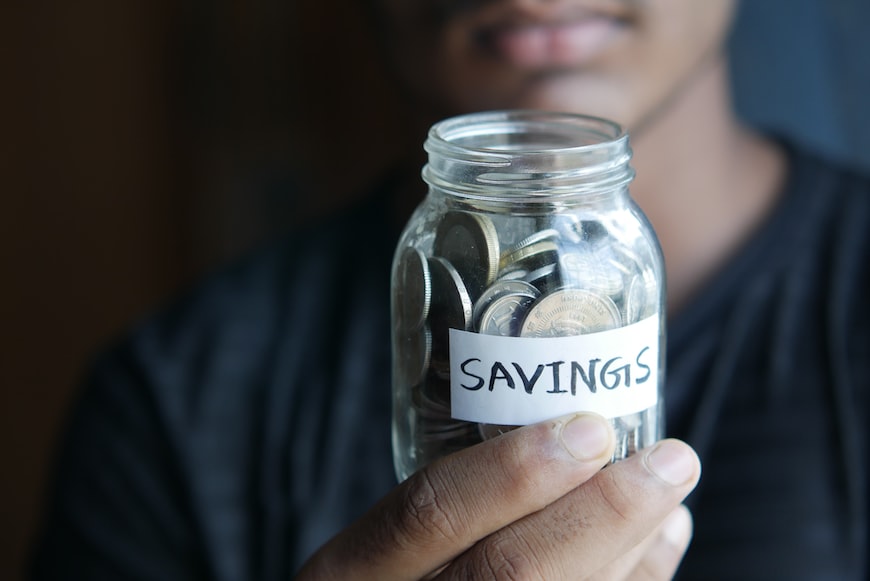Last updated Mar. 3, 2023 by Charles Zemub
It’s easy to feel you’re not making progress when saving money. Small expenses creep up, and everything is a hard-to-afford luxury. But there are plenty of ways to save over $1,000 per year on things that might not seem important right now—or even worth cutting back on!
We will cover some basic things you can do daily to help you save hundreds or thousands of dollars a year.
Save Your Tax Refund

If you didn’t know better, you’d think the government was giving you a gift when they sent a tax refund each year. But that’s not the case: it’s your money. You earned it, and they’re just returning it to you.
So instead of viewing your tax refund as something that doesn’t belong to you and should be spent, see it for what it is: an opportunity to save more money or pay off debt.
You can also use some of your hard-earned cash from Uncle Sam to invest for retirement or towards savings goals like buying a house or car down payment.
Take Advantage of Employee Perks
Your employer is likely to offer some perks that can save you money. From cell phones, internet, and cable packages to gym memberships and museum memberships, there are some ways employers can help employees find ways to save money.
Many companies offer discounts on cell phones, internet, and cable packages if you purchase through them directly. For example, suppose you have an unlimited data plan with your carrier but don’t need all the features available with an Android or Apple device (super expensive). In that case, you might consider switching to a cheaper phone without those features.
There are many good options out there! On top of these savings potentials at work, many companies also offer discounted gym memberships and other local activities, such as museums or attractions around town, as well as travel options like cruises and airfare (if they’re traveling for business).
Get Creative About Date Night
When your other half is tired of going out to eat every night, try getting creative about what you do on date night. For example, if you’ve always been a couple who loves trying new restaurants, consider trying something different (and cheaper), like a museum date or play.
Or maybe head outdoors and go hiking, biking, or kayaking together. You could even plan a road trip through the countryside and stop at various points for picnics.
Cook at Home
If you’re in the habit of eating out, cooking at home can save you a lot of money. But it’s not just about saving money—it also allows you to control what goes into your food and how it’s prepared.
As a result, you can use cheaper ingredients and make better decisions about what kind of fats, carbs, and protein is good for your body in the long run. Plus, cooking at home is healthier than ordering takeout or going out with friends because there aren’t usually any extra calories (aside from whatever might be in those drinks).
Cooking at home also feels more rewarding because pride comes from knowing you made something by hand without relying on someone else’s expertise or recipe book.
The process can be fun: chopping vegetables is satisfying; watching water boil can be mesmerizing; taking out a pizza stone takes patience but is worth doing once weekly, so your bread will cook evenly when making garlic knots. For dinner tonight!
Cooking with family members or friends adds another dimension to this feeling of accomplishment—feeding yourself and sharing an experience with others that brings people together around something intangible yet meaningful: community through food.
Cut Back on Coffee
To cut back on coffee, try to reduce your consumption by half and then make an effort to switch over to tea. If you’re feeling ambitious, you can even try making coffee at home, which will also save money (and help you get better at it).
You could also cut out sugar in your coffee or switch it to stevia or honey. Also, consider cutting out milk and cream from your drinks—they won’t be as creamy, but they’ll still taste good.
Use Your Library

Did you know that the library is your best friend when saving money? This includes everything from books and movies to the internet and phone, transportation, school supplies, insurance—you name it.
Thanks to the widespread availability of digital media these days (and libraries’ growing collections), you can save hundreds of dollars each year by using the following tips.
Find Cheaper Entertainment
You can save money by finding cheaper entertainment. Try walking and hiking, going to the library, doing a free museum or concert, and more!
Take advantage of your local library. Most libraries offer free internet access, books, magazines, and movies for people who live in that area.
See a movie at an indie theatre or check out a classic on Netflix instead of renting it from Redbox or buying a Blu-Ray disc from Amazon. If you love music concerts but don’t want to pay $40 per ticket at an arena show, try checking out local bands at smaller venues with lower ticket prices (or even free).
Cancel Your Unused Subscription Services
A subscription service is a great way to pay for something regularly, but you should be careful about how many subscriptions you have.
When you sign up for a subscription service, you agree to pay a certain amount of money on an ongoing basis. For example, with Netflix, if you subscribe at the lowest level (which costs $8 per month), then that’s what they’ll charge every month until you cancel. It can add up fast!
If your subscription is still active after 90 days without use (for most services), they may charge another activation fee when it is time for renewal.
That means that if your credit card expires and gets updated before the next billing cycle rolls around next month (or year), there’s no guarantee that your new account information will get updated in time before they try charging again.
This could result in overdraft fees or other problems with payment processing at checkout time because of confusing error messages/systems/etc.
How to save 10000 in a year
To save 10000 in the next year, you’ll need to set up a budget and start saving automatically. You can do this using an online tool like Mint.com or Personal Capital. They’ll help you track your spending so you know where your money is going, and then they’ll find ways for you to save more of it automatically—either through a high-interest account or into a tax-advantaged account (like an IRA).
There are also some other options for how to save 10000:
For example, a short-term account could be used if you want something specific right now and don’t want to wait until later, but be careful not to use these accounts as an excuse not to invest in longer-term savings like stocks or bonds! It’s better not.
How to save 5000 in a year
If you want to save $1,000 over a year, here’s what you do:
- Save $3 per day.
- Save $10 per week.
- Save 10% of each paycheck. (This is called “paycheck planning.” You can set up an automatic transfer from your checking account to savings.)
You’ll be able to save more than just five grand if you make a goal for yourself and keep track of how much money you’ve saved every day, every week, and every month.
Frequently Asked Questions
How can I save $1000 in 6 months?
It sounds simple, but the most effective way to save $1000 in 6 months is to save $1 daily. The goal of saving money is to free yourself from debt, build an emergency fund, and have enough money for retirement.
So how can you achieve this?
Make a budget: Sit down with pen and paper and list all your expenses for the next month (rent/mortgage, utilities, food, etc.). Next, write down how much money you earn each month after taxes (your net income).
Finally, if there’s not enough left over, consider where else you can cut back on expenses by reviewing options such as switching energy companies or changing health insurance providers.
Set goals: Knowing where your money will go will help create a plan—so set some goals! Perhaps it’s paying off credit card debt or saving for something special like a new TV.
Make a plan: With your goals set now, it’s time to start planning how exactly you will achieve these things! Think about what steps need to be taken to reach each one.* Save more than spend:
When we talk about saving, we mean putting money away into safe places like savings accounts instead of spending it on groceries or rent – so try this rule rather than “keep more than spend.
How much will I have if I save $100 a week?
You save $100 a week for the next 40 years. You’ll have an estimated $51,000 in your account. That’s pretty good! But you’ll also pay about $15,500 in taxes that year, leaving you with $35,500. Not bad at all!
Let’s look at another example where we assume your investments earn more than 1% interest per year and grow by 10% annually over those same 40 years:
$100/week x 52 weeks = $5200 saved per year:
40 x 5200 = 207,600 saved over a lifetime (40 years):
207,600 invested at 10% return = 21,760 in interest earned each year on average (207k x 0.1 growth factor): $21k annual tax bill since IRA contributions are not tax deductible: If an individual contributes more than they can deduct from their income tax return this results in extra income that must be taxed at regular rates; if less then the remainder is refunded
How does the 100 envelope Challenge work?
The 100 envelope challenge works by having you put $100 into a separate envelope every week. You then place the envelopes safely until you’re ready to spend them.
The goal is to save up to $10,000 over five years. That means that you’ll be saving $20 per month, which might seem like a lot at first glance—but if you’re not spending all that much money now and can commit yourself to save more than $100 per week for even just three months, then this challenge should be easy enough for anyone.
How to save $10,000 in 4 months
If you want to save $10,000 in four months, here are some tips to help you get started.
Start small. It can be easy to think that saving $100 a week is impossible and give up before even giving it a shot, but if you start with just $5 or even $1 per week and keep at it for a few months, the savings will add up quickly.
Once you see how much money your “tiny” weekly savings add to each month, increase the amount by another dollar or two. You might save so much money that within six months or less—halfway through your goal—you may have already reached it!
Budget like crazy. The best way to jumpstart your savings habit is by making an honest budget for all your expenses and sticking with it!
Even if it means cutting back on things like going out with friends or buying coffee every day at work (like I did), these sacrifices are well worth their weight in gold when they lead directly toward something as awesome as financial freedom down the road…which leads me right into my next point.
What are the five tips for saving money?
Don’t buy things you don’t need.
Avoid going out to eat, and make your meals at home instead of purchasing them elsewhere.
Don’t buy expensive clothes, jewelry, or electronics—you don’t need them
How much is $5 a day for a month?
$5 a day is $150 a month, which is not a lot of money, but it’s enough to make a difference.
You can add extra cash to your other expenses when you save on groceries and transportation. Here are some ways you can save money:
Pack your lunch instead of buying it at the deli or restaurant.
Take public transit instead of driving or using ride-sharing apps like Uber or Lyft.
Turn off lights in rooms that aren’t being used (or leave them on if it’s dark outside). You don’t need to keep lights on 24/7
Summary
Saving is hard, but small steps can help.
Saving is hard, but it’s even harder if you wait until you have an emergency before trying to save. Don’t wait until the next crisis happens; start saving now so that when life throws a financial curveball at you, your savings are there to help.
Making small steps part of your routine is the best way to save money. What is the easiest way to do this? Cut out spending on coffee and other unnecessary expenses.
Saving money is hard, but it’s not impossible. You can do this! It all adds up, even if you save only a few dollars at a time. And remember that saving money doesn’t have to be all or nothing—it’s okay if you don’t get your finances in order overnight. Small steps like turning off lights when you leave the room or bringing your mug to work are great ways to start saving now and for the future.







